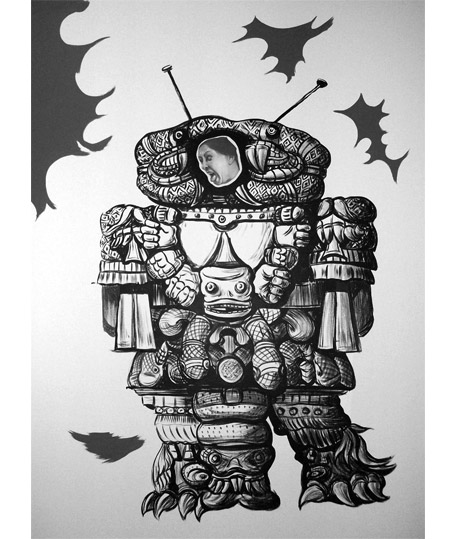The New World
Featuring Guadalupana March
Curated by Roman Stollenwerk
Curated by Roman Stollenwerk
15 January - 16 March 2013
Wignall Museum of Contemporary Art
Chaffey College
5885 Haven Avenue, Rancho Cucamonga, California
Reception: Tuesday, January 22, 6-8pm
Guadalupana March, 2013
Mixed Media Installation, 40 x 14 feet
Mythology, religion, superstition, and day-to-day reality coexist in Guadalupana March to illustrate how faith systems in Mexico have changed through time to accommodate societal climates. Three distinct modes of veneration are at play: the ancient, conveyed through Aztec goddess Coatlicue, the accepted, conveyed through the Catholic icon Virgen de Guadalupe, and the appropriated, conveyed through the cult of Santa Muerte (Saint Death).
The Aztecs celebrated the goddess Coatlicue, who gave birth to the moon, stars, and the sun. Their civilization depended on agriculture and Coatlicue was worshipped in order to honor and explain the cycle of life. Centuries later, the Spanish came and brought with them Catholicism. The integration of this new religion with existing Aztec beliefs was pivotal to suppress and control the indigenous masses. The Virgen de Guadalupe became the “Queen of Mexico,” and replaced Coatlicue with her miracles and visions. Recently, Santa Muerte, the patron saint of the drug war, has emerged and threatens to eclipse the sanctity and influence of the Virgen as Mexican society is more and more driven by drugs, corruption and power.
Guadalupana March manifests the idea that structures of belief are subject to evolve, yielding to the type of society that it serves. On the left, a corn cart carried by angel wings represents the migrant’s honest work. Their livelihood depends on maize, the indigenous crop, Crosthwaite’s ode to the region’s history and culture. However, Santa Muerte jeers and tempts those who labor for a living. A triad of marchers bears the tattered image of the Virgen de Guadalupe on electric poles that serve as makeshift crosses, symbolizing modern adaptations of faith. The procession approaches the new saint, Santa Muerte, a crowned image that echoes the composition of traditional retables of the Virgen in an elliptical sunburst. These false idols glorify cartel violence and the cult of death. Finally, by manipulating Coatlicue’s ancient image, adding antennas and the face of a Mexican woman sticking out her tongue, the artist comments on the debasement of time-honored mythology and religion in modern Mexican society as the deity takes a step towards the present.
Crosthwaite, paying homage to Goya's "A Pilgrimage to San Isidro,” mimics the procession of devout worshipers by his satirized characters that march across the landscape. The mixed media installation exposes the social and political themes of current aspects of a society that has succumb to worshipping power through money, consumerism, and politics.
Chaffey College
5885 Haven Avenue, Rancho Cucamonga, California
Reception: Tuesday, January 22, 6-8pm
Guadalupana March, 2013
Mixed Media Installation, 40 x 14 feet
Mythology, religion, superstition, and day-to-day reality coexist in Guadalupana March to illustrate how faith systems in Mexico have changed through time to accommodate societal climates. Three distinct modes of veneration are at play: the ancient, conveyed through Aztec goddess Coatlicue, the accepted, conveyed through the Catholic icon Virgen de Guadalupe, and the appropriated, conveyed through the cult of Santa Muerte (Saint Death).
The Aztecs celebrated the goddess Coatlicue, who gave birth to the moon, stars, and the sun. Their civilization depended on agriculture and Coatlicue was worshipped in order to honor and explain the cycle of life. Centuries later, the Spanish came and brought with them Catholicism. The integration of this new religion with existing Aztec beliefs was pivotal to suppress and control the indigenous masses. The Virgen de Guadalupe became the “Queen of Mexico,” and replaced Coatlicue with her miracles and visions. Recently, Santa Muerte, the patron saint of the drug war, has emerged and threatens to eclipse the sanctity and influence of the Virgen as Mexican society is more and more driven by drugs, corruption and power.
Guadalupana March manifests the idea that structures of belief are subject to evolve, yielding to the type of society that it serves. On the left, a corn cart carried by angel wings represents the migrant’s honest work. Their livelihood depends on maize, the indigenous crop, Crosthwaite’s ode to the region’s history and culture. However, Santa Muerte jeers and tempts those who labor for a living. A triad of marchers bears the tattered image of the Virgen de Guadalupe on electric poles that serve as makeshift crosses, symbolizing modern adaptations of faith. The procession approaches the new saint, Santa Muerte, a crowned image that echoes the composition of traditional retables of the Virgen in an elliptical sunburst. These false idols glorify cartel violence and the cult of death. Finally, by manipulating Coatlicue’s ancient image, adding antennas and the face of a Mexican woman sticking out her tongue, the artist comments on the debasement of time-honored mythology and religion in modern Mexican society as the deity takes a step towards the present.
Crosthwaite, paying homage to Goya's "A Pilgrimage to San Isidro,” mimics the procession of devout worshipers by his satirized characters that march across the landscape. The mixed media installation exposes the social and political themes of current aspects of a society that has succumb to worshipping power through money, consumerism, and politics.


